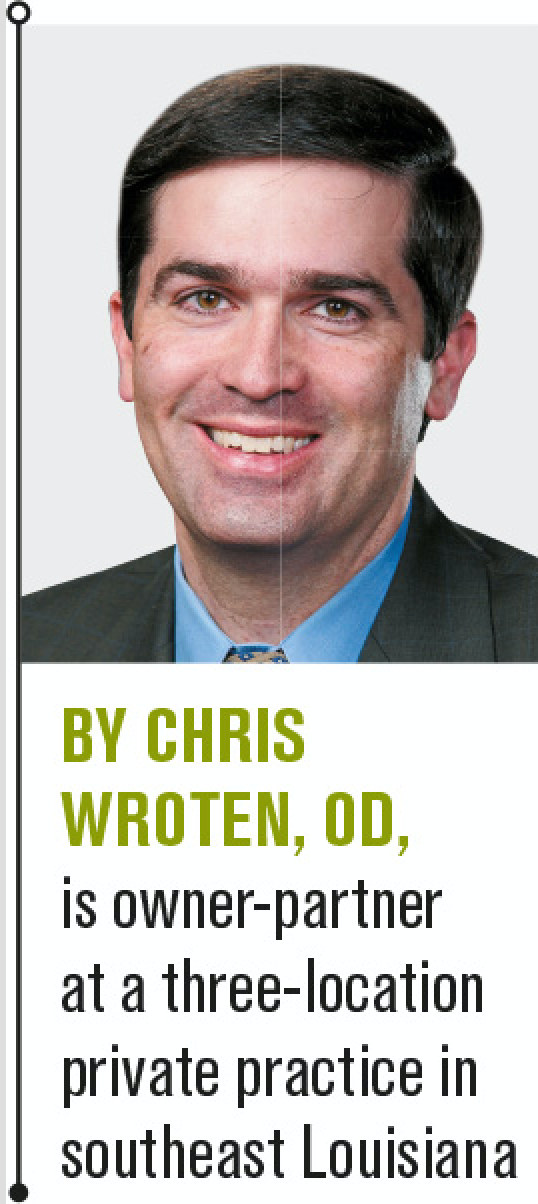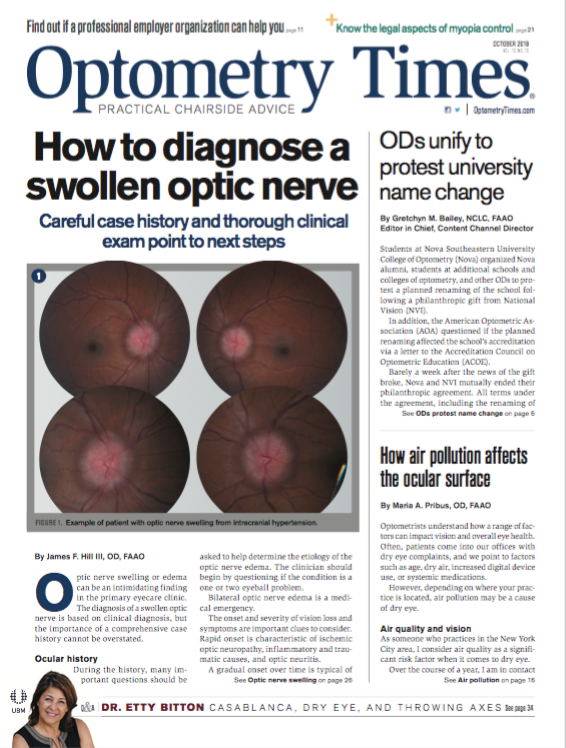How to know if a professional employer organization can help you

One of the biggest challenges a practice owner faces is the administrative side of small business. ODs are well trained in clinical care, but many of us feel overwhelmed with the business management of a practice, especially evaluating finances, setting up business policies, and handling human resources (HR).
While ODs learn some of these skills in optometry school, such tasks demand significant time and attention to master. In addition, when students are exposed to them, they usually don’t yet have the real-world experience to put them into context.
About PEOs
A professional employer organization (PEO) provides comprehensive human resource solutions for small to mid-size businesses by allowing owners to outsource tasks such as:1
• HR management
• Benefits administration
• Payroll processing
• COBRA and worker’s compensation
• Tax administration/compliance
• State unemployment insurance
• Recruiting support
• Risk/safety management
• Staff training and development
• Regulatory compliance
By handling required paperwork and providing regulatory compliance assistance, PEOs can potentially help practices focus more on their primary mission while simultaneously improving productivity and profitability.
Related: How staff can help differentiate your practice
According to the National Association of PEOs (NAPEO), staff can gain access to enhanced employee benefits traditionally reserved only for large corporations, such as:2
• 401(k) plans
• Insurance (health, dental, life)
• Worker’s compensation
• Dependent care
• Other perks not typically available to employees of small companies
Roughly 175,000 U.S. businesses have determined the benefits outweigh these risks and costs, and have contracted with one of the 907 PEOs now operating across the country.3 This means that PEOs in the U.S. cover a collective annual payroll of $176 billion, representing 3.7 million workers.4
As a result of this ability to leverage the collective buying power of large numbers of employees aggregated from numerous employers, PEOs have become increasingly popular in the past three decades.
Operating in all 50 states and internationally, PEOs can have in-depth knowledge of employment regulations and best practices at both the national and state levels while offering business owners the freedom to concentrate on other aspects of their businesses.
Small companies working with a PEO grow 7 to 9 percent faster, have 10 to 14 percent lower employee turnover, and are 50 percent less likely to go out of business, according to NAPEO.5
Read more on practice management
PEOs are able to offer their services by establishing a contractual arrangement in which they “co-employ” a business’s staff, thereby assuming certain employer rights, risks, responsibilities, and obligations, including becoming the employer of record for tax purposes.
Thus, the PEO would file employees’ W2s, but the practice would retain control and oversight of its staff. This differentiates a PEO from an employee leasing company or temporary staffing service. PEO contracts can be tailored to meet the individual needs of the practice, depending on what a la carte services are desired.
In addition to reducing the administrative burden on practice owners, NAPEO reports that on average, annual administrative costs are $450 lower per employee for businesses that utilize a PEO.6
Pricing and more
PEOs charge a fee based on a percentage of the employee’s salary, and rates vary by PEO and depending on what services are contracted. Fees range between 3 to 15 percent of gross payroll (averaging out to $500 to $1500 per employee per year).7
Other PEOs charge a flat rate per employee, which can start as low as $49 per employee per month for basic services.7
Keep in mind that transitioning HR to the PEO disrupts the status quo and could appear less personal to your employees, but the practice owner or a designated staff member will continue to serve as the link between employees and the PEO.
If the practice offers health insurance through the government’s health insurance exchange (SHOP Exchange), contracting with a PEO may eliminate some current tax savings.8 In addition, moving to a PEO may also lead to future changes in insurance coverage if the PEO decides to adjust coverage and/or change providers.
Related: 5 steps to maximize your optical profit
Additionally, depending on the terms of the PEO contract, the practice may need to consult the PEO before firing an employee; however, such a requirement may prevent mistakes in doing so.
If the PEO goes out of business, there is also the risk of having to fund one payroll twice because most contracts require prepayment of fees; however, this is unlikely, especially if dealing with an established PEO.1
Finally, look to contract with an IRS-certified PEO because if it fails to properly remit or file taxes on the practice’s behalf, the PEO-not the practice-is liable.9
To determine if a PEO is right for you:10
• Calculate current employee benefit needs and costs (including worker’s compensation and unemployment insurance)
• Estimate how much time and financial resources are annually spent on administrative duties by the owner(s), staff, and ancillary personnel
• Contact certified PEOs (NAPEO website is a great place to start) to compare fees and services
• Research PEOs for client and professional references, independent audits by a CPA, certifications, and those authorized to do business in your state
• Ask an attorney to review the contract for each party’s responsibilities and liabilities, guarantees, and cancellation terms
Wrapping up
Even if a PEO is ultimately not a perfect fit for your practice, considering one creates a great opportunity to review, better understand, and improve your practice’s HR needs and costs. With today’s increasingly challenging healthcare and employment environments, every little bit can help.
• 98 percent of businesses currently working with a PEO would recommend them to a colleague
• Annual median revenue growth for PEO users is twice that of comparable non-PEO businesses
• PEO users were 16 percent more likely to report an increase in profitability
• Employees working for PEO users reported higher levels of commitment to the business
Disclosures:
1. D’Angelo M. A Guide to PEOS and Employee Leasing. Available at: https://www.businessnewsdaily.com/2391-outsourcing-human-resources.html. Accessed 10/3/18.
2. National Association of Professional Employer Organizations. FAQS. Available at: https://www.napeo.org/what-is-a-peo/selecting-a-peo/faqs. Accessed 10/3/18.
3. Bassi L, McMurrer McBassi D. An Economic Analysis: The PEO Industry Footprint in 2018. Available at https://www.napeo.org/docs/default-source/white-papers/2018-white-paper-final.pdf. Accessed 10/3/18.
4. National Association of Professional Employer Organizations. Industry Statistics. Available at: http://www.napeo.org/what-is-a-peo/about-the-peo-industry/industry-statistics. Accessed: 10/3/18.
5. National Association of Professional Employer Organizations. About the PEO Industry Overview. Available at: https://www.napeo.org/what-is-a-peo/about-the-peo-industry/overview. Accessed 10/3/18.
6. National Association of Professional Employer Organizations. NAPEO White Papers. Available at https://www.napeo.org/what-is-a-peo/about-the-peo-industry/napeo-white-papers. Accessed: 10/3/18.
7. Intuit QuickBooks. Should Your Small Business Work with a Professional Organization? Available at: https://quickbooks.intuit.com/r/hr-laws-and-regulation/should-your-small-business-work-with-a-professional-employer-organization/. Accessed 10/3/18.
8. Handrick L. Professional Employer Organization (PEO): Definition and Features. Available at: https://fitsmallbusiness.com/professional-employer-organization-peo/. Accessed 10/3/18.
9. Grassley C. S. 479 Small Business Efficiency Act. Available at: https://www.congress.gov/bill/113th-congress/senate-bill/479. Accessed 10/3/18.
10. National Association of Professional Employer Organizations. Guidelines For Choosing a PEO. Available at: https://www.napeo.org/what-is-a-peo/selecting-a-peo/guidelines-for-choosing-a-peo. Accessed 10/3/18.
11.Bassi L, McMurrer D. PEOS: Good for Businesses and Their Employees. Available at: https://www.napeo.org/docs/default-source/white-papers/2017-napeo-white-paper-final.pdf?sfvrsn=2. Accessed: 10/3/18.

Newsletter
Want more insights like this? Subscribe to Optometry Times and get clinical pearls and practice tips delivered straight to your inbox.